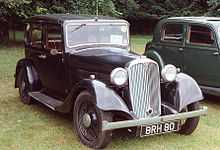Rover 10
The Rover 10 was a small family car from the British Rover car company produced between 1929 and 1947.
Rover 10/25
| Rover 10/25 | |
|---|---|
 | |
| Overview | |
| Manufacturer | Rover |
| Production | 1929-1933. 15,000 approx made[1] |
| Powertrain | |
| Engine | 1.2 L straight 4 |
| Transmission | 3- or 4-speed manual |
| Dimensions | |
| Wheelbase | 104 in (2,600 mm)[2] |
| Length | 156 in (4,000 mm)[2] |
| Width | 62 in (1,600 mm)[2] |
| Chronology | |
| Predecessor | Rover 9 |
The 1929 Rover 10/25 was based on the earlier Rover 9 which it replaced. The car was conventional with leaf spring suspension all round, half elliptic at the front and quarter elliptic at the rear with rigid axles. The four cylinder, overhead valve engine had a capacity of 1185 cc and had at first magneto ignition. Drive was to the rear wheels through a three speed gearbox. The magneto was replaced by coil ignition in 1929.
In order to keep weight down many of the cars had fabric bodies using the Weymann system.
In 1929 the car was available as either the Riviera saloon with fully opening roof at GBP250 or a Sportsman's Coupé at GBP269.
An updated version appeared in 1931 with four speed gearbox and new chassis. All steel bodies made by Pressed Steel Ltd and also used on the Hillman Minx were introduced at a new low price of GBP189. The existing Weymann bodied Riviera and Sportsman models continued and were joined by an upmarket Coachbuilt model with two tone colour scheme. A Regal model was introduced in 1933 with wire wheels replacing the artillery ones and bumpers front and rear.
Rover 10 1933-1938
| Rover 10 | |
|---|---|
 | |
| Overview | |
| Manufacturer | Rover |
| Production | 1933-1938. 9202 made[1] |
| Designer | Maurice Wilks and Robert Boyle |
| Body and chassis | |
| Body style | saloon, coupé, open tourer |
| Related | Rover 12 |
| Powertrain | |
| Engine | 1.4 L straight 4 |
| Transmission | 4-speed manual |
| Dimensions | |
| Wheelbase | 105 in (2,700 mm)[2] |
| Length | 152 in (3,900 mm)[2] |
| Width | 61 in (1,500 mm)[2] |
The 1933 10 was really a new car with new chassis and new 1389 cc engine. It was the first car to be developed by Rover after the Wilks brothers Spencer and younger brother Maurice joined the company. The car was relatively expensive at GBP238 - the Austin 10 was GBP168 - and reflected the new company policy of moving upmarket rather than chasing volume. The Pressed Steel body was continued but there were no more fabric bodied models. Chassis were also supplied to a wide range of external coachbuilders.
The engine was flexibly mounted in the chassis to reduce vibration and a freewheel device was fitted to help gear changing on the non-synchromesh gearbox and save fuel, a 15% improvement in economy was claimed. The freewheel would continue to be a feature of some Rovers until 1959.

Rover 10 1939-1947
| Rover 10 | |
|---|---|
 | |
| Overview | |
| Manufacturer | Rover |
| Production |
1939-1947 2,640 made post war[3] |
| Powertrain | |
| Engine | 1.4 L straight 4 |
| Transmission | 4-speed manual |
| Dimensions | |
| Wheelbase | 105 in (2,700 mm)[2] |
| Length | 163 in (4,100 mm)[2] |
| Width | 62 in (1,600 mm)[2] |
The final version of the 10 was launched in 1939. The chassis was slightly modified getting an extra half inch (12 mm) in the wheelbase and the engine got a new cylinder head increasing power from 44 to 48 bhp. Synchromesh was fitted to the top two ratios on the gearbox. The body was restyled in the Rover style of the time. The price was now GBP275 for the saloon but few were made before the outbreak of war and production stopping in 1940.
The Coventry factory was damaged by bombing in November 1940 and when production restarted it was from the new Solihull works. The cars were little changed but a left hand drive version to help the export drive arrived in 1947 along with an optional heater.
The final cars were made in 1947.
References
- ↑ 1.0 1.1 Sedgwick, M. (1989). A-Z of Cars of the 1930s. Devon, UK: Bay View Books. ISBN 1-870979-38-9.
- ↑ 2.0 2.1 2.2 2.3 2.4 2.5 2.6 2.7 2.8 Culshaw; Horrobin (1974). Complete Catalogue of British Cars. London: Macmillan. ISBN 0-333-16689-2.
- ↑ Sedgwick, M.; Gillies. M (1986). A-Z of cars 1945-1970. UK: Bay View Books. ISBN 1-870979-39-7.
- The Rover Story. Graham Robson. 1977. Patrick Stephens Ltd. ISBN 1-85260-175-2
- The Rover Ten. Jonathan Wood. The Automobile June 1999. ISSN 0955-1328